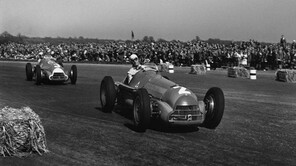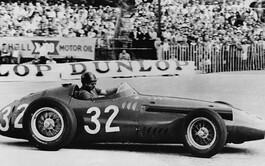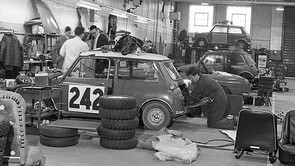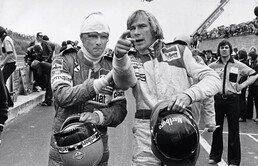It's the most prestigious racing series in the entire world.
It's the pinnacle of speed, power, and skill. The most advanced cars on the planet are driven by the most skilled racers. The drivers are going 100 miles an hour faster than planes take off. It's the world's top manufacturers fighting on the most glamorous circuits to see who can build the best race car in the galaxy. This is everything you need to know to get up to speed on Formula One.
You also can't imagine your life without F1? Find yourself glued to the screen every time your favorite racers hit the track? Or, maybe, you prefer watching F1 races live? You can sacrifice your sleep, precious leisure time, or study hours and buy a dissertation abstract online to be able to enjoy the best sports show on the planet? Then, you might find today's post particularly interesting.
 The Beginning...
The Beginning...
In the early 1900s, rich guys were racing their fancy jalopies from town to town around Europe in a hastily organized contest called Grand Prix. Then, WWII happened, and the guys were deprived of this privilege. But it didn't take long for people to start racing after the war ended. In 1947, the Federation Internationale de l'Automobile, or FIA, was founded. The new organization immediately created a bunch of racing series centered around Grand-Prix-style racing with the top tier called Formula A, which quickly turned into Formula One. The only rule was that the engines couldn't be bigger than 2.5 liters, and they had to be naturally aspirated. Besides that, the sky was the limit. These new engines and rules brought new teams to complete with the old. While the classic Gatsby-like race teams generally had old-timey drivers, newcomers like Lancia and Mercedes got drivers of their own.
 1950s
1950s
Both companies set out to hire the best available. Lancia hired Alberto Ascari, while Mercedes availed themselves of Juan Manuel Fangio's help. And those guys were really insane. They were tearing down backcountry roads wearing nothing but a leather helmet and a crazed grin. It's hard to believe today, but back then, they didn't even have seatbelts. Fangio and Mercedes were a dominant pair, having won the 1954 and 1955 seasons back-to-back. But after a horrific accident involving one of its cars at Le Mans, killing 83 spectators, Mercedes decided to abandon motorsport altogether. Almost simultaneously with Mercedes' departure, crashes would also force Lancia out and sadly, take the life of Ascari. Lancia sold all of their Formula 1 equipment and development to Ferrari and just washed their hands of the entire sport.
Ferrari would take the development from Lancia and hired the now jobless Fangio, who would win the 1956 championship. He then left Ferrari for Maserati and won another championship. And finally, in 1957, Fangio decided to retire from racing when he was kidnapped by Fidel Castro.
 1960s
1960s
In 1959, the Cooper racing team made an innovation that would change racing and cars forever. The team moved the engine from in-front of the driver to behind his butt. This totally changed how the car drove and made it way better. By 1961, every team was using a mid-engine layout in their cars. And they still do!
At the start of the 1967 season, British team 'Lotus' would introduce the Ford Cosworth DFV 3 liter V8 to the world. It powered the now legendary Lotus-49. Lotus had exclusive rights to the engine for one year, but it was so good that every team wanted it. And it would go on to power almost every Formula 1 car for the next decade.
Ferrari, being Ferrari, didn't want somebody else's engine, so they decided to build their own. Figuring more is more, they tried to combat the V8 with the flat 12. Not only did these things sound amazing, they also made a ton of power.
With almost everybody using one of these two engines, smaller teams started using any technological innovation they could sneak past the rules. Soon, some insanely experimental cars started to hit the grid, including four-wheel drive racers, cars with six wheels, and even a car with a fan to suck it to the road through corners.
 1970s
1970s
The 70s were a perfect balance of rock-star attitude and technical innovation. And no two drivers of that period embodied the yin and yang better than Niki Lauda and James Hunt.
Lauda was a reserved and meticulous Austrian, who drove for Ferrari, while Hunt was a rowdy playboy. Off the track, these two respected each other. But on it, there might never be a fiercer rivalry. Their story was so good that a few years ago, they made a big old Hollywood movie about it called 'Rush'.
In 1977, Lotus introduced an evolving ground effect aerodynamic kit, which not only increased down force, but also reduced drag. The Lotus didn't rely on wings pushing cars down, but shaped the bottom of their cars like an upside-down airfoil. This essentially made an entire car a wing with none of the drag.
All good things must come to an end. And the Cosworth engine could not last forever. In 1978, Renault introduced forced induction to the sport. Up until 1978, teams had figured that with the technology available at that time any competitive turbocharged engine would be too laggy, and any supercharged engine would be too inefficient. But Renault managed to use turbos at La Mans and decided to roll the dice and see what a little boost could do for Formula 1. And it turns out that a little boost goes a long way!
The aging DFF could only muster about 500 horsepower in its most developed form. But Renault's turbo motor was matching that power on its very first outing. Soon, after a bit of development, Renault was making 700 horsepower, and the rest of the constructors began to take notice. The insane power to rate ratios meant that drivers achieved speeds and times previously only dreamed of, cementing their names in the history book.
And there were tons of things going on with Formula 1. No wonder, so many people are crazy about this classy, sophisticated, mega exciting, and always unpredictable sporting event.
























